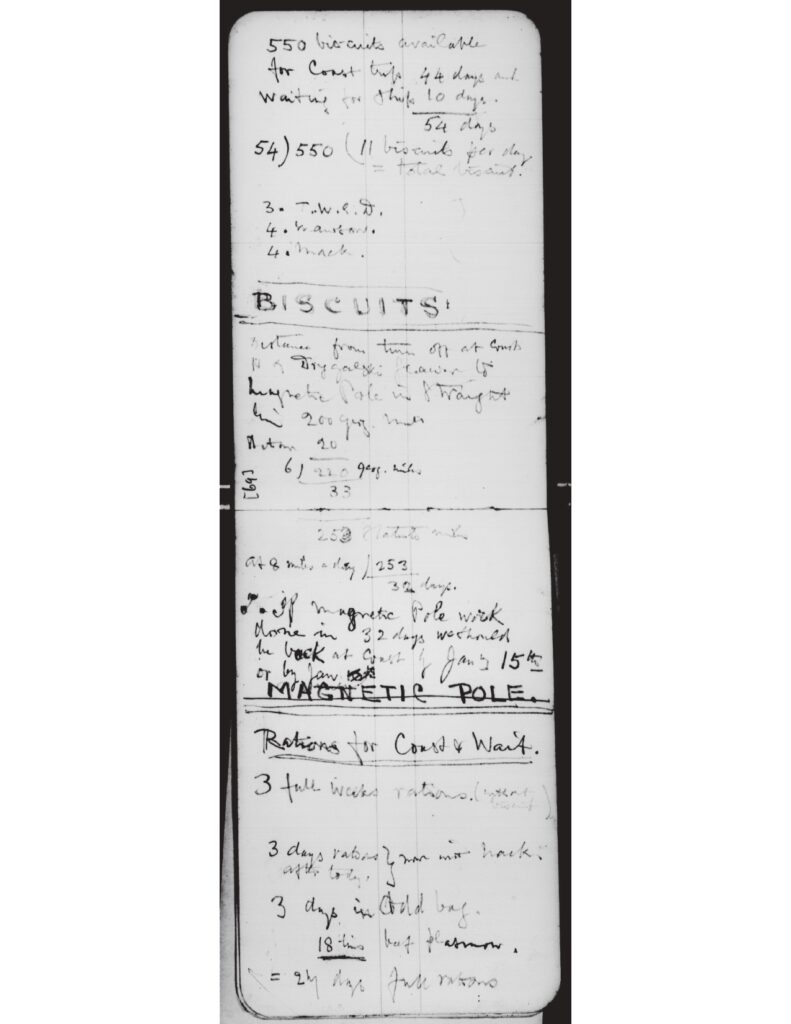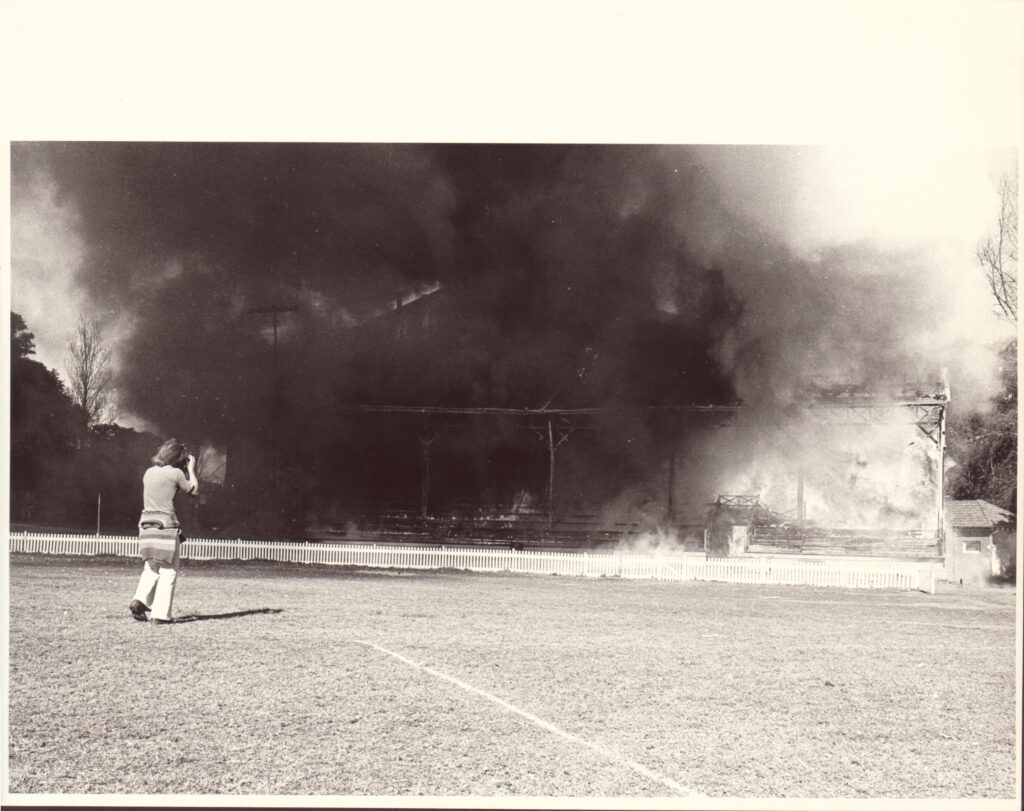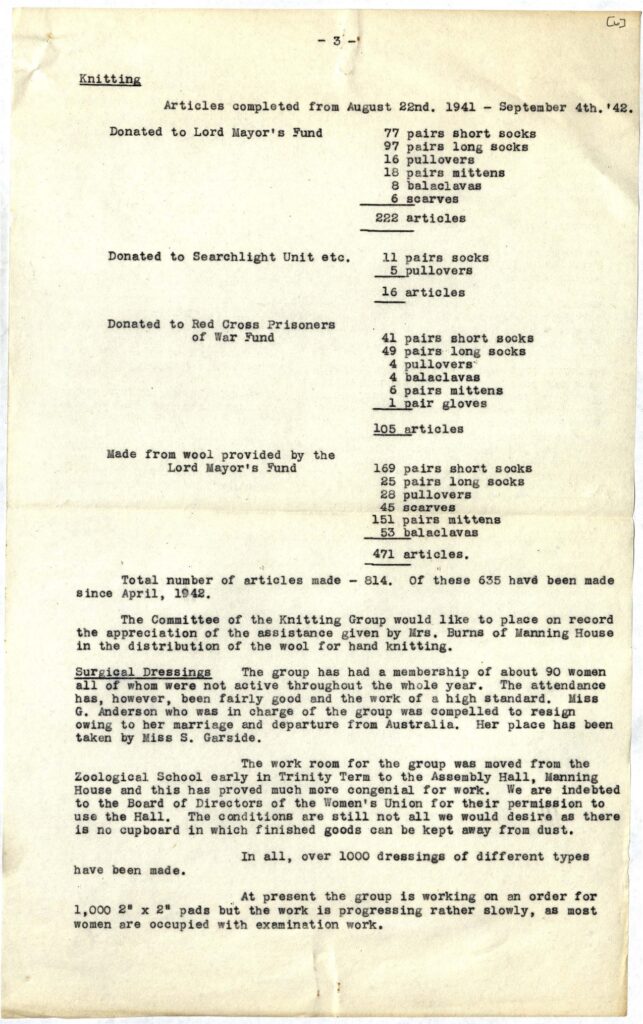The University Archives turns 70 on 3 May this year. To celebrate this milestone, check the blog at the end of each week for the week’s special stories from our collections.

23 January 2024
How Many Biscuits Do You Need to Reach the Magnetic South Pole?
This notebook was written by Professor Sir Tannatt William Edgeworth (TWE) David, Professor of Geology from 1891 to 1924, who was invited to be part of the Northern Party of Ernest Shackleton’s 1907-1909 British Antarctic Expedition by Shackleton himself. On 9 December 1907, Senate resolved that, “Upon the application of Professor David, a sum of £100 was granted towards the expenses of Lieutenant Shackleton’s Expedition to the Antarctic Regions in consideration of the invitation extended to Professor David and two other graduates of the University to accompany the Expedition and the promise of Geological and Natural History specimens for the University Museums”.
Professor David was only to be part of the Expedition until April 1908, however, Senate reported on 2 March 1908 that, “The letter from Professor David dated the 13th of January, written on board the S.Y. “Nimrod”, applying for leave of absence for the year 1908, as he had agreed to the proposal of Lieut. Shackleton that the young scientists on his staff should be placed under Professor David’s general direction…was considered at length, and the leave of absence granted”.
Professor David manuscripts on the Expedition detail the day he, along with Douglas Mawson and Alistair Mackay, reached the area of the Magnetic South Pole and later enjoyed one of the biscuits they packed for the journey, “Saturday, January 16th. We were up at about 6 a.m., and after breakfast we pulled on our sledge for two miles…fixed up the legs of the Dip Circle to guide us back on our track, the compass moving in a horizontal plane being now useless for keeping us on our course…two miles further put up our tent, and had a light lunch…we then walked five miles in the direction of the Magnetic Pole so as to place us in the mean position calculated for it by Mawson…Mackay and I fixed up the flag pole. We then bared our heads and hoisted the Union Jack at 3:30 p.m. with the words uttered by myself, “I hereby take possession of this area now containing the Magnetic Pole for the British Empire.”…Then we gave three cheers for His Majesty, the King…The temperature at the time we hoisted the flag was exactly 0 deg. F. It was an intense satisfaction and relief to all of us to feel that at last after so many days of toil, hardship, and danger we had been able to carry out our Leader’s instructions, and to fulfil the darling wish of Sir James Clarke Ross that the South Magnetic Pole should be actually reached, as he had already in 1831 reached the North Magnetic Pole. At the same time we were too utterly weary to be capable of any great amount of exultation…With a fervent ‘Thank God’ we all did a right-about turn…reaching the tent we each had a little cocoa, a biscuit, and a small lump of chocolate”.
Field Notebooks of 1907-1909 British Antarctic Expedition (28/02/1908 to 1909), [REF-00086304]. University of Sydney Archives, accessed 23/01/2024, https://archives-search.sydney.edu.au/nodes/view/138946.
24 January 2024
In the Pursuit of an Instagrammable Shot
On 28 May 1975, the grandstand at Oval No. 1 went up in flames and, despite best efforts, was destroyed within 30 minutes. The week after the inferno, the front page of the Uni News declared that the grandstand, “…bowed out with one of the most spectacular performances seen at No. 1 Oval in recent years”. The article added that, “…despite last minute efforts to apply to dampers, it was no match for its fiery opponent, and in a blistering 30 minutes the game was over”.
“Before its defeat”, $100,000 renovations were planned for the grandstand, however, the destruction of the structure saw the University confronted with costs amounting to more than $250,000 to replace the ruined building.
Conflagration Grandstand – Fire (28/05/1975), image 011 [REF-00019039]. University of Sydney Archives, accessed 24/01/2024, https://archives-search.sydney.edu.au/nodes/view/40859.


25 January 2024
We Can Do It!
The Sydney University Women’s War Auxiliary was formed in response to World War II, allowing women associated with the University to contribute to the war effort. The Union Recorder reported on 20 June 1940 that, “A crowded meeting of women in the University was held last Thursday in the Assembly Hall of Manning House…convened by Dr Joplin and Miss Telfer to put before all women of the University the various ways on which they could help….plans have been formed and various branches of activity are now well under way. Women here can play their part by joining up one or all of the following sections: First Aid and V.A.D. work…the Knitting Group…the War Dressing Unit…The Knitting Group already has three machines which have been made possible by the kind donations from several members of the staff. There are two sock machines and one pullover machine. The sock machines turn out about eight pairs of socks a day, and the pullover type makes about one pullover an hour”.
The 1941-1942 annual report of the Auxiliary recorded that 814 items were made and donated by the Knitting Group, with special thanks given to Mrs Burns of Manning House for the wool.
Sydney University Women’s War Auxiliary Minutes (24/06/1940 to 31/10/1945), p. 7 (PDF), [REF-00003177]. University of Sydney Archives, accessed 25/01/2024, https://archives-search.sydney.edu.au/nodes/view/26201.
Explore the blog for other posts from the University of Sydney Archives and follow us on Instagram.
